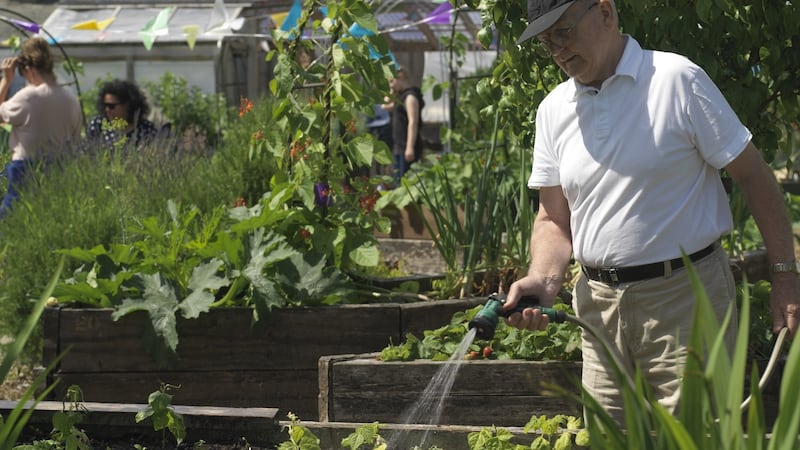Whether it’s cultivating a window box filled with herbs or creating a fully productive kitchen garden, growing a little of your own food and flowers is one of the most joyful, life-affirming and empowering things that we can do during this pandemic.
In last week's column I shared my tips on useful books, websites, YouTube channels and Irish suppliers of seeds and gardening equipment, as well as how to get a head start by raising plants from seed sown indoors undercover.
This week I want to share some tips on getting started outdoors in terms of site selection and soil preparation, both of which are fundamental to the success of even the tiniest kitchen garden.
Let’s start with the cardinal rule, which is that the vast majority of fruit, vegetables and cut-flowers require a fertile, weed-free, moisture-retentive but free-draining soil and a sheltered position in full sun well away from the competing root systems and shade of established trees and shrubs. So don’t give them the shadiest, dankest, weediest corner of your garden or courtyard where they will inevitably struggle to survive.
Bear in mind also that most deciduous trees and shrubs have yet to come into leaf, so what seems like a bright spot at this time of year may well turn out to be a very shady one come summer. High walls and buildings will also cast shade but as a general guide, a south- or west-facing spot is best in terms of ensuring that your plants gets as much bright sunshine as possible.
That said, there are some leafy vegetables, herbs and even fruit bushes that are quite happy in light (but not deep) shade: examples include beetroot, kale, radish, kohlrabi, broccoli, Swiss chard, salad leaves, leeks, carrots, herbs such as parsley, mint and chives, and fruit such as raspberries, rhubarb, gooseberries and blackcurrants.
Next, let’s talk about soil. In an ideal world yours would be a deep, dark, moist, crumbly loam, rich in organic matter and plant nutrients with a pH of between 6 and 7.5. But the reality is that it’s far more likely to be compacted, low in organic matter and starved of nutrients, especially if you live in a new build. To improve it, you’ll need to single-dig to a depth of 20cm and add plenty of well-rotted organic matter in the shape of manure or garden compost.
Start by marking out the area and then digging a trench 40cm wide and 20cm deep along its length, piling this first lot of excavated soil to one side. Use a fork to loosen the soil at the base of the trench and then add a generous layer of well-rotted manure or compost. Then dig a second parallel trench about 15cm wide, placing the excavated soil from this into the first trench beside it. Continue in this fashion until you’ve dug the last trench, filling this by using the soil set aside from the very first trench you’ve dug.

If you’re making your new beds on an area of lawn or rough grass, mow or strim before you start and make sure to upturn the excavated soil as you go, placing the sods upside down into the previously excavated trench.
If you're making your veg beds in a very overgrown part of the garden, then cut back or strim all the heavy overgrowth and remove the established root systems of any perennial weeds or woody shrubs. Beds made using this technique must be left alone for about 5-6 weeks to properly settle before they can be used but in the meantime you can be busily sowing seed under cover (see last week's column) to give you lots of baby plants ready to transplant into it come late spring.
Examples of herbs and vegetables that can be sown undercover at this time of year include cabbage, leeks, perpetual spinach, Swiss chard, lettuce, turnip, Brussels sprouts, scallions, cauliflower, courgettes, French beans, runner beans, alpine strawberries, coriander, parsley and basil. You could also start onions and potatoes in modules or pots for planting out later.
If you can get your hands on some decent topsoil or multipurpose compost, a faster, less laborious alternative to single-digging is to build some raised beds. These can be contained using lengths of hardwood timber or decking, recycled plastic, bricks or even sheets of metal and are perfect for courtyards and paved areas. To keep costs and labour down, they can be as low as 30cm while if freestanding, they should be no wider than 120cm but if built against a wall, then no wider than 90cm. Their speed and ease of construction aside, raised beds have many other advantages, offering gardeners an excellent, accessible, space-efficient, labour-efficient way to give plants the sort of fertile, free-draining conditions that result in optimum yields. They also look very decorative, something definitely worth bearing in mind during these weeks (or possibly months) of confinement.
Useful list of Irish suppliers:
Cork-based Gee-Up for cubic-metre bags (€110) of well-rotted, weed-free, certified-organic horse manure delivered to gardeners living within a 110-mile radius of Blarney; Donegal-based Envirogrind for multipurpose, screened, nutrient-rich compost as bulk sacks (1 cubic metre €118 including nationwide delivery); Meath-based Enrich compost for a certified organic, screened, peat-free, nutrient-rich, multipurpose compost available in either cubic-metre bags or as a loose load; Quickcrop for a range of raised timber beds delivered in kit form plus soil/compost to fill them.













